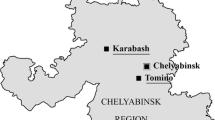Abstract
This study was performed to investigate trace elements and arsenic contents among Sudanese inhabitants living in the north, east, and west of Sudan. Inductively coupled plasma atomic emission spectrometry was used to determine the contents of Zn and Cu. Graphite furnace atomic absorption spectrometry was used to determine Se in serum samples. It was found that Se and Cu are in the normal range. Zinc showed discrepancies among all studied groups. Acute Zn deficiency was detected in the northern and eastern regions of Sudan. Inductively coupled plasma mass spectroscopy was operated in the dynamic reaction cell mode to determine the arsenic content in the nail samples of the northern inhabitants of Sudan. High values of arsenic were found in the northern people compared with the control group. This elevation could be linked to the misuse of insecticides and herbicides which might be associated with the high rate of cancer incidence in this region.


Similar content being viewed by others
References
Al-Sayer H, Al-Bader A, Khoursheed M, Asfar S, Hussain T, Behbehani A, Mathew A, Dashti H (2000) Serum values of copper, zinc and selenium in adults resident in Kuwait. Med Princ Pract 9:139–146
Crayton J, Walsh W (2007) Elevated serum copper levels in women with history of post-partum depression. Trace Elem Med Biol 21:17–21
Ebrahim A, Eltayeb M, Shaat M, Mohmed N, Eltayeb E, Ahmed A (2007) Study of selected trace elements in cancerous and non-cancerous human breast tissues from Sudanese subjects using instrumental neutron activation analysis. Sci Total Environ 383:52–58.
Federal Ministry of Health (2007) Annual health statistical report, 2007, National Health Information Centre, Federal Ministry of Health Khartoum, Sudan
Hartikainen H (2005) Biochemistry of selenium and its impact on food chain quality and human health. Trace Elem Med Biol 18:309–318
Hatfield D, Berry M, Gladyshev V (2006) Selenium its molecular biology and role in human health, 2nd edn. Springer, New York
Heitland P, Koster H (2006) Biomonitoring of 37 trace elements in blood samples from inhabitants of northern Germany by ICP-MS. Trace Elem Med Biol 20:253–262
Hussein Were F, Njue W, Murungi J, Wanjau R (2008) Use of human nails as bio-indicators of heavy metals environmental exposure among school age children in Kenya. Sci Total Environ 393:376–384
Izquierdo S, Castañón SG, Ruata ML, Aragüés EF, Terraz PB, Irazabal YG, González EG, Rodríguez BG (2007) Updating of normal levels of copper, zinc and selenium in serum of pregnant women. Trace Elem Med Biol 21S1:49–52
Jaspers I, Zhang W, Brighton L, Carson J, Styblo M, Beck M (2007) Selenium deficiency alters epithelial cell morphology and responses to influenza. Free Radic Biol Med 42(12):1826–1837
Kafai M, Ganji V (2003) Sex, age, geographical location, smoking, and alcohol consumption influence serum selenium concentrations in the USA: third National Health and Nutrition Examination Survey, 1988–1994. Trace Elem Med Biol 17(1):13–18
Markert B (2007) Definition and principles for bioindication and biomonitoring of trace metals in the environment. Trace Elem Med Biol 21:77–82
Michael B, Stengel C, Trang P, Viet P, Sampson M, Leng M, Sopheap S, Fredricks D (2007) Magnitude of arsenic pollution in the Mekong and Red River Deltas Cambodia and Vietnam. Sci Total Environ 372:413–425
Miyazaki K, Ushijima K, Kadono T, Inaoka T, Watanabe C, Ohtsuka R (2003) Negative correlation between urinary selenium and arsenic levels of the residents living in arsenic contaminated area in Bangladesh. J Health Sci 49(3):239–242
Osman EH (2007) Assessment of terrestrial gamma-radiation in Northern state. M.Sc. thesis, Sudan Academy of Sciences, Khartoum, Sudan
Romero C, Sánchez P, Blanco F, Rodríguez E, Majem L (2002) Serum copper and zinc concentrations in a representative sample of the Canarian population. Trace Elem Med Biol 16:75–81
Rudolf E, Cervinka M (2008) External zinc stimulates proliferation of tumor Hep-2 cells by active modulation of key signalling pathways. Trace Elem Med Biol 22:149–161
Samanta G, Sharma R, Roychowdhury T, Chakraborti D (2004) Arsenic and other elements in hair, nails, and skin-scales of arsenic victims in West Bengal, India. Sci Total Environ 326:33–47
Saiki M, Jaluul O, Sumita N, Vasconcellos M, Filho W (2007) Trace element contents in serum of healthy elderly population of metropolitan Sao Paulo area in Brazil. Trace Elem Med Biol 21(S1):70–73
Schulpis K, Karakonstantakis T, Gavrili S, Chronopoulou G, Karikas G, Vlachos G, Papassotiriou I (2004) Maternal–neonatal serum selenium and copper levels in Greeks and Albanians. Eur J Clin Nutr 58:1314–1318
Selinus O, Alloway B, Centeno J, Finkelman R, Fuge R, Lindh U, Smedley P (2005) Essential of medical geology impacts of the natural environment on public health. Elsevier, Singapore, p 581. ISBN 0-12-636341-2
Slotnick M, Nriagu J (2006) Validity of human nails as a biomarker of arsenic and selenium exposure: a review. Environ Res 102:125–139
Spallholz J, Porte L, Alauddin M, Ahmed S, Chakravorty B, Zuberi I, Marshall J, Shea C, Westfall P, Robertson J, Ross L, Umbaugh S, Feldmann J, Tchounwou P, Gailer J, Pickering I and George G (2006) Selenium against arsenicosis in Bangladesh and West Bengal (India). A proposed, placebo-controlled, randomized, double-blind phase III clinical trial to assess the efficacy of selenium dietary supplements in countering signs of arsenic toxicity in the context of the Bangladesh arsenic crisis. Available at: http://www.bangladesh-selenium.org/documents/La%20Porte%20Phase%20III%20clinical%20trial.pdf
Walingo MK (2009) Indigenous food processing methods that improve zinc absorption and bioavailability of plant diets consumed by the Kenyan population. AJFAND 9(1):524–535
Acknowledgments
The practical work was done with the help and understanding of the staff of the Institute of Ecological Chemistry and the financial support of Helmholtz Center Munich-German Research Center for Environmental Health, Neuherberg, Germany, and DAAD.
Author information
Authors and Affiliations
Corresponding author
Rights and permissions
About this article
Cite this article
Ebrahim, A.M., Eltayeb, M., Benker, B. et al. Study on Some Trace Element Contents in Serum and Nail Samples Obtained from Sudanese Subjects. Biol Trace Elem Res 144, 225–233 (2011). https://doi.org/10.1007/s12011-011-9076-z
Received:
Accepted:
Published:
Issue Date:
DOI: https://doi.org/10.1007/s12011-011-9076-z




